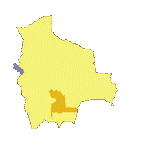The white city of America
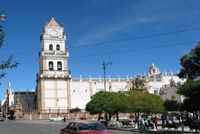 Sucre
Sucre ![]() is located 750 km South of La Paz
(10 hours by bus or 45 minutes by plane) in a valley of medium altitude (2,800m) at the foot of the Andes.
is located 750 km South of La Paz
(10 hours by bus or 45 minutes by plane) in a valley of medium altitude (2,800m) at the foot of the Andes.
Sucre is a small and peaceful town of 200,000 inhabitants which has managed to preserve the charm of its colonial history. In an effort to retain this impression, it has been requested that all the buildings in the centre of town retain their traditional white painted style and the locals, mindful of their heritage, are happy to oblige.
Sucre has particularly mild and pleasant climate, similar to that of Cochabamba. The average temperature is around 15 degrees C.
The city with four names
Sucre was founded in 1538 by Pedro de Anzures. The town was renamed several times: Charcas (before the Spanish domination), La Plata (1538), puis Chuquisaca (1776), and finally Sucre a short time after the declaration of Bolivian independence in 1825. The city draws its name from the Marshal Sucre, Lieutenant of Bolivar and victor in battle of Ayacucho.
Constitutional capital of Bolivia
During the period of Alto Peru, Sucre and the neighboring town, Potosí used to be the center of political and economic power for the Spaniards. Sucre remained capital of Bolivia for several decades, until La Paz took the legislative and executive power at the end of the XIXth century. Nowadays, the Bolivia has two capitals: La Paz (the administrative capital) and Sucre (the constiutional capital, judicial center and home of the bolivian supreme court).
Cultural Capital of Bolivia
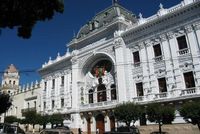 The small and peaceful capital of the province of Chuquisaqua
was declared a UNESCO World Heritage Site in 1991. Sucre is arguably the most beautiful town in Bolivia, and it
can be justly proud of its many monuments and art treasures from the colonial period. The city is remarkably well
preserved to date, and has been described as a "living museum". Sucre has managed to escape from the harmful
effects of industrialization - effects which blighted La Paz when it became the new capital of Bolivia in the
XIXth century.
The small and peaceful capital of the province of Chuquisaqua
was declared a UNESCO World Heritage Site in 1991. Sucre is arguably the most beautiful town in Bolivia, and it
can be justly proud of its many monuments and art treasures from the colonial period. The city is remarkably well
preserved to date, and has been described as a "living museum". Sucre has managed to escape from the harmful
effects of industrialization - effects which blighted La Paz when it became the new capital of Bolivia in the
XIXth century.
Many students of Bolivia come to Sucre to be educated in the famous university "Universidad de San Francisco de Xavier". The university takes its name from the founder of the first Bolivian university built in Sucre in 1624.
Historical milestones
- Before taking its Spanish name, Sucre (named Charcas at that time) was the indigenous capital of the Choque Chaca valley.
- Around 1530, the Inca empire collapsed and Francisco Pizarro sent his brother Gonzalo to the region of Charquas in order to manage the silver mines.
- In 1538, the city of "La Plata" (the money) founded as Spanish capital of Charcas.
- In 1559, the king of Spain Felipe II creates the Audiencia, royal court of Charcas based in La Plata and in charge of the management of the eastern territories of Alto Peru.
- 1622 foundation of the first university of Bolivia by San Fransisco de Xavier.
- The Audencia was replaced in 1776 by the vice royal of La Plata to bolster power in the territories bordering Brazil, in response to the Portuguese threat. The city of La Plata was renamed Chuquisaca at this time.
- Beginning in 1809, sources of rebellion against the Spanish power appear in the country. Ideas about independence start to develop and spread.
- In 1824 the Spanish army is routed in Junín (August 6) and Ayacucho (December 9)
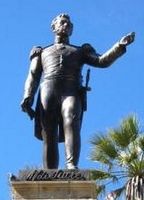 1825, Marshal Sucre convenes in Chuquisaca the leaders of each province
of Alto Peru to discuss the future of the nation. On August 6 (in honor of the Junín battle), Independence is proclaimed
at the
casa de la libertad
1825, Marshal Sucre convenes in Chuquisaca the leaders of each province
of Alto Peru to discuss the future of the nation. On August 6 (in honor of the Junín battle), Independence is proclaimed
at the
casa de la libertad  (house of freedom). The new Republic was originally called República Bolívar and was then renamed
República de Bolivia (on October 3, 1825). The city of Chuquisaca becomes Sucre.
(house of freedom). The new Republic was originally called República Bolívar and was then renamed
República de Bolivia (on October 3, 1825). The city of Chuquisaca becomes Sucre.- Bolivar was not in favour of Independence for Bolivia, because that was contrary to his ideal of reunification of the South American people in a single large nation. However, after having accepted the plebiscite, Bolivar became the first president of Bolivia.
Historical Sucre
- Catedral Métropolitana (1559 - 1712) on the square 25 de Mayo, remarkable for its external architecture (including a tower decorated with statues).
- Oratorio de San Felipe Neri (1795) with its neo-classic style.
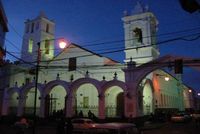 Churches of San Francisco (1581), San Miguel (1621), La Merced (1550), San Lázaro (1544), Santo Domingo, San Agustín.
Churches of San Francisco (1581), San Miguel (1621), La Merced (1550), San Lázaro (1544), Santo Domingo, San Agustín.- Casa de la Libertad: splendid colonial palace modified into a Jesuit monastery and then into a university. This museum documents the history of the independence of Bolivia. It is here that visitors will find the original document of the declaration of independence of Bolivia.
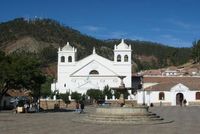 Convent of the Recoleta
Convent of the Recoleta  (1601): four cloisters and a church and a museum with an old collection of
religious and Indian objects.
(1601): four cloisters and a church and a museum with an old collection of
religious and Indian objects.- Convent Santa Clara (1639): museum exhibiting pieces of XVIIth century religious art.
- University museums inside the Palacio del Gran Poder (XVIIth century): one of the largest museums in Bolivia, housing an extensive art collection from the colonial period, religious objects, and Indian handcraft from the pre-colonial time.
- Textile and ethnographic museum.
- The
cemetery
 : a quiet place to come to rest in the shaded alleys lined with tombs and mausoleums belonging to rich and famous local
families. It is possible to take a guided tour.
: a quiet place to come to rest in the shaded alleys lined with tombs and mausoleums belonging to rich and famous local
families. It is possible to take a guided tour.
Excursions around Sucre
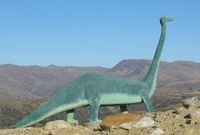 Cal Orcko
Cal Orcko  : a 25 square kilometer calcareous wall covered with footprints left by dinosaurs
nearly 65 million years ago. This unusual site is in the middle of a cement factory ("Fancesa") 10 km North of Sucre.
: a 25 square kilometer calcareous wall covered with footprints left by dinosaurs
nearly 65 million years ago. This unusual site is in the middle of a cement factory ("Fancesa") 10 km North of Sucre.- La Glorieta: pink brick castle of XIXth century, located approximately 5 km from Sucre.
-
Tarabuco
 : village located 60km of Sucre famous for its artisan market on Sundays (featuring colored textiles and monteras, musical instruments...).
: village located 60km of Sucre famous for its artisan market on Sundays (featuring colored textiles and monteras, musical instruments...).
